70 Aufkläerungspanzer (Reconnaissance Vehicle) 38(t)s were produced in February/March 1944 with the "Haengelafette 38" (suspended mount) turret with KwK38 gun as used with the Sd.Kfz.250/9 and Sd.Kfz.234/1 added to a revised superstructure as well as an up-rated engine with the long range Fu 12 radio set and star antenna fitted to some but not all vehicles. There was some detail differences between those produced with alternate style of drive sprockets and idler wheels fitted as well as the use of the MG34 on initial vehicles with the MG42 on most. As no vehicles have survived in museums only a handful of period photos exist of the Aufkläerungspanzer 38(t) and photos of the trial and mock up vehicles show the longer FlaK38 barrel fitted while the production vehicles had the shorter KwK38 barrels, which is something to watch for when viewing the available photos.
One feature of the 38(t) is that the hull and turret panels are joined by a combination of domed rivets and domed hexagonal bolts, with most of the vertical surfaces having rivets and the top surfaces (glacis, superstructure and engine deck) as well as the driver’s plate and mantlet having the hexagonal bolts. This is not easy to see at any distance but close examination will show the different rivets/bolts (the new Wings & Wheels 38(t) book shows this in good close-up.)
The different rivets/bolts are represented on the kit glacis but are quite understated on the engine deck and can only be seen with some form of magnifier but the effect is there. This probably gives a scale effect when looking at the kit and it’s good this feature is recognised as it’s easy to overlook, the same comments apply to the Tristar 38(t) kits which also incorporate the feature with some bolts more prominent than others.
Obviously for this kit the turret doesn’t apply as the upper superstructure top is secured with flush screws and not rivets which are depicted nicely on the kit.
This kit of the Aufkläerungspanzer 38(t) mit 2cm KwK38 Sd.Kfz.140/1 from Dragon is the first of their Pz.Kpfw.38(t) series with the Pz.Kpfw.38(t) Ausf.G (kit #6290) already announced to follow shortly.
It consists of 323 parts in light grey plastic, 4 in clear plastic with approximately 60 etched parts plus a bag of individual “magic tracks” and the decal and instructions sheets with most parts being from the forthcoming 38(t) Ausf.G (sprues marked accordingly) and the turret sprues from the Sd.Kfz.234/1 (kit #6298) with the revised superstructure for this kit on sprue H. This gives an insight into what to expect with the Ausf.G and others that may follow with a number of the Ausf.G parts marked “not for use” in the instructions.


Dimensionally the kit measures up well against the available plans listed below with just some very minor discrepancies not really worth mentioning apart from the barrel length which we’ll get to shortly but there are a couple of detail issues thrown in.
The lower hull tub has the floor and both sides moulded together and cleaver use of slide moulds sees well defined detail on both sides of the hull walls for the inner fighting compartment and insides of the final drives and of interest is mountings at the back for an engine which we may see in the Ausf.G kit?
Detail on the tub exterior is very good with rivet detail on the bottom and sides as well as the idler mountings included with separate final drive covers and return roller mountings.
The separate front plate is in two parts to not compromise the detail on the upper and lower sections with the fit very good as is the separate tow shackles but you should not attach this plate to the hull until the interior is done or there may be problems fitting the transmission/gearbox if you do attach the front plate now.
On the inside are two part final drive fittings and front brackets which fit snugly to the inner side walls with the transmission/gearbox having crisp details included for all the basic detail including the cooling ribs on the gearbox and textured drive shaft cover. The driver’s controls are in one piece and fairly basic and there is no driver’s foot pedals included with three part seats but the mountings are very basic plus the distinctive wooded mat for the lower floor is included. The rear engine firewall is included which again has the basic detail although the lower side sections should extend a little further out with good images of this in the new Wings & Wheels book on the 38(t).
Once the transmission/gearbox is assembled this should be fitted inside the hull and you will have to flex out the front sidewalls slightly to insert the pins on the drive shafts (parts D46) into the final drive fittings (parts D55/56) and this is the reason for leaving the front plate separate as you won’t be able to flex the sidewalls to fit the transmission with the front plate in place.
The rear firewall and drive shaft fit neatly in place as do the seats and the front plate can then be fitted but again you may have to flex out the side walls slightly to get this in place but the fit is good with the glacis also fitting neatly in place with the transmission visible through the separate inspection hatch and of course it’s best to paint the interior before adding the glacis and superstructure.
The separate glacis inspection hatch fits neatly into place without any problems and added to the glacis is the Notek light which has an etched part for the light face and the mounting bracket for added detail.
Added to the hull sides are the separate fenders which are moulded commendably thin with rib embossing raised on the top and indented underneath for some of the nicest plastic fenders that probably negate the need for etched replacements. The fender support brackets are all separate parts and also moulded nice and thin with a channel embossed along the hull side to locate the fenders.
There is an issue here as the real 38(t) fenders have a distinct upward kink half way along the fender length with the kit fenders mounded perfectly straight. Included with the kit is a jig on sprue B for the kink contour and the instructions indicate you should bend the fenders using this jig as a guide.
Unfortunately the locating channel along the hull side is also perfectly straight and does not allow for the kinked fenders meaning if you do add the fender kink the fenders will not fit into the channel and the front of the fender will not mate to the top of the glacis/final drive housing as this is where the straight fender meets. So there is a fair bit of work involved altering the locating channel and other angles to incorporate the kink or just live with straight fenders. It seems someone knew of this but forgot to tell the pattern makers?
Tristar kit for comparison with the fender kink included.


Other items added to the fenders are the typical perforated 38(t) storage box which is provided in both plastic and etched metal depending on your preference along with two large solid storage boxes carried on the rear fenders. All the tools are moulded nicely without attachment clips which are provided on the etched fret to add a nice detail touch.
At the back is the separate rear plate which has the central round inspection hatch as a separate part and other smaller fittings including early and late style idler mounting brackets. Care is needed when fitting the rear plate as the rear hull tub sidewalls are bowed inward slightly at the top and careful coaxing was needed to fit the panel which straightens the hull walls in the process.
Each suspension bogie is made up of the hull mounting, two separate swing arms and the leaf spring unit with the swing arms attached with a face plug that allows the arms to move but the springs are glued in place so these is only downward movement possible for the wheels after assembly. The fine mould lines on the springs are easy to remove with the bogie units fitting together as you attach to the hull side as the spring locating pin is on the hull side and also used to locate the bogie mounting plate.
The wheels are the correct size and have the correct number of rim bolts on both sides of the wheels and these simply glue to the axle stubs on the swing arms while the two part drive sprockets (with separate hub cap) and idlers wheels also have detail on both sides of the wheel discs. The drive sprockets have the inner lightening holes as well as the eight outer lightening holes while the idlers have the teardrop shaped lightening holes included. These designs are correct but note that photos exist of the vehicle with the drive sprockets without the outer holes and the idlers with round lightening holes, so if modelling a particular vehicle this should be taken into account if photos exist?
The return rollers have nice hub detail as well as the “continentau” embossing on the side wall but it’s a little oversized if you want to get real picky but will look good when painted and weathered to highlight the embossing, and it’s easy to convert the ‘u’ to an ‘l’ if you want to do this.
These are provided as individually moulded “magic tracks” which
have nice detail including minute casting numbers on the edge of each link
with no cleanup required.
The tracks are designed to be glued together and are not workable and you will
have to incorporate the track sag as you glue the lengths together. By gluing
a length together and letting the glue “go off” you can them add
it to the suspension and add the curve around the drive sprockets and idlers
as well as the track say easier.

The assembled track runs look very good but if you prefer workable track links which take care of the track sag themselves then those from WWII Productions would be a simple alternative.
The Sd.Kfz.140/1 has a distinctive upper superstructure that is angled out over the fenders and the kit gives you a full superstructure with separate angled side sections, front driver’s plate and rear plate. The rivet and flush screw detail on the superstructure plates is nicely done with the rivets all moulded perfectly despite the varied plate angles.
The fit of the lower side panels (parts H13, H15) was not the best and some
coaxing or minor trimming may be needed. (disregard
this line)
Update January 24: The problem here
is the part numbers are transposed in the instructions, part H13 should go
where part H15 is indicated (on the RHS) and visa versa with part H15 where
part H13 is indicated (on the LHS), the panels then fit perfectly okay, (thanks
Kazutaka).
The driver’s plate has internal detail such as clear periscopes and driver’s instrument panel with etched dial faces with separate outer visor covers with etched brackets. Added inside the superstructure are four 20mm ammo boxes and the Fu 12 radio as well as the aerial mount on the left rear corner of the superstructure with a finely moulded plastic ‘star’ aerial which while quite thin would look better if replaced by thin wire or in etched metal.
Fitting the driver’s plate to the superstructure results in a distinct step at both sides and along the top, this is correct for the sides but the top should be flush with the bolted plate above it which is evident in photos of the Sd.Kfz.140/1 and this would entail extending the upper plate out to meet the front driver's plate with a bit of cutting involved.
Image of actual vehicle showing the flush top join (Allied-Axis Issue 17)
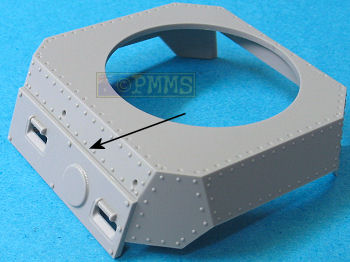
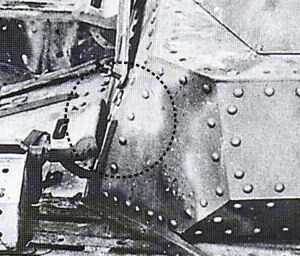
At the rear is the separate engine deck with separate side engine access hatches as well as separate rear intake grill section with the engine deck having nice details including the representation of the hex bolts as mentioned above.
The grills located under the lip of the engine access hatches is provided as etched parts but these are not representative of the actual grills being the wrong mesh style and are located on the outside of the hatches when they should be located inside the hatch lip.
The etched screens and location is correct on the Tristar 38(t) hatches as indicated by the image here from the new Wings & Wheels book on the 38(t). Yes these are images of the Ausf.B/D but I am not aware these screens changed for the later Ausf.G but if someone has updated info I’m always open to this as always.

The separate small intake grill has an etched screen cover provided as well as the sliding cover that requires the sides to be bent to shape which is quite easy using a good bending tool, I used the original Etch Mate for the job without any problems. One thing to watch is when you bend the side with the opening for the sliding cover to ensure you make the bend so the slot is fully open and not bent half way into the opening but if careful the cover will easily slide open and closed after assembly.
Note; muffler supports should not be attached to the etched frame as shown here, see below.

The exhaust pipe is attached on small brackets and you have to cut out a section of the upper engine deck for the pipe which is indicated as being square but the front edge should be rounded so take note of this as you cut out the opening. The exit pipe is nicely hollowed out for a good look once the exhaust to fitted in place.
On fitting the exhaust pipe it was found the pipe itself is about 3mm too
long resulting in the exhaust muffler not sitting on the brackets correctly. (disregard
this line)
Update January 24: This again is due to an error in
the instructions which show to fit the muffler supports (parts H7, H8) to the
etched mesh frame (part MA1), this is incorrect. The muffler supports should
be attached to the top of the rear plate about 1mm from the top but there was
still some trimming of the pipe where it enters the engine cover and altering
the angle of the pipe from the muffler required for a good fit.
the etched frame as indicated in the instructions

The six sided "Haengelafette 38" turret with KwK38 gun and MG42 is the same as included in the Cyber-hobby Sd.Kfz.251/23 Ausf.D (Kit #6293[02]) and Dragon Sd.Kfz.234/1 (kit #6298) with the only difference in this kit being the etched screens are pre-bent.
The real "Haengelafette 38" turret and KwK38 gun was fitted to the Sd.Kfz.250/9, Sd.Kfz.234/1 as well as the Aufkläerungspanzer 38(t) with the KwK38 gun used in other vehicles such as the Sd.Kfz.222 and Luchs Light Tank.
You should take care when looking at wartime photos of the vehicles, the Sd.Kfz.222 especially as this could be fitted with any of the 2cm barrels and is often seen with the longer FlaK38 barrel fitted but usually with the earlier eight sided turret.
The kit turret has the upper six sided walls with separate lower turret ring which includes fine traverse teeth and mountings for the various additional parts.
The gun mounting is very detailed with separate mountings for the KwK38 and co-ax MG42 as well as the ammo spend shell cases and side mounting brackets plus the lower crew seats, traverse hand wheels and radio mounting with the details matching very well compared to the detailed turret photos included in the Museum Ordnance Special #24 Sd.Kfz.234 book.
Included with this kit is a single plastic KwK38 cannon moulded in one piece including the flash suppressor but as reported in the Cyber-hobby Sd.Kfz.251/23 kit review the barrel is 3mm too long when compared to the 1:35 plans in the Panzer Tracts No.13 Panzerspaehwagen Armored Cars Sd.Kfz.3 to Sd.Kfz.263 book.
The Panzer Tracts plans are those stated on both the Dragon site and by their technical advisors as a major source for scaling these kits, therefore with this discrepancy using those same plans would indicate either the Panzer Tracks plans are wrong or the kit barrel is wrong. As always I am open to additional information regarding these findings should anyone be able to provide same?
To illustrate this point further and also to show you shouldn’t hang your hat on one source basically because if you just use a set of plans or ordnance drawings these may have the overall dimensions but miss some of the finer detail and it is probably best to check with a real example to get a better perspective of real life.
I have scanned the barrel from 5 different sets of 1:35 plans dating back a few years and these clearly show some are seriously wrong and can’t be used (scans B,C,D). The plan (B) in the Panzer Tracts No.11-2 Aufkläerungspanzerwagen being a prime example where photographs that accompany the plan clearly show the barrel is shorter as depicted in their plans in the No.13 Panzerspaehwagen Armored Cars book.
KwK38 barrel plans;
- A. Panzer Tracts No.13 Panzerspaehwagen Armored Cars; Sd.Kfz.222, Sd.Kfz.234/1.
- B. Panzer Tracts No.11-2 Aufkläerungspanzerwagen (Full and Half-Tracked Armored Reconnaissance Vehicles); Sd.Kfz.250/9, Sd.Kfz.140/1.
- C. Ground Power No.74 7/2000; Sd.Kfz.234/1.
- D. Tank Power No.241 PzKpfw 38(t); Sd.Kfz.140/1.
The image below shows the kit barrel overlayed with the scanned 1:35 barrel from the Panzer Tracts No.13 plan (pages 13-15 and 13-40) showing the 3mm discrepancy as well as the armorscale KwK38 barrel (set #B35-048) included for further comparison. And of course anyone with the kit and the Panzer Tracks book are welcome to do the same to see the results for themselves, don’t just take my word for it.
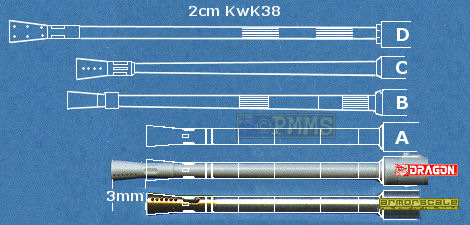
Also included is the same exercise with the longer FlaK38 barrel to indicate the barrel in this kit is different again and the plans B, C and D are wrong here as well, also note the Dragon FlaK38 barrel is correct, only this KwK38 barrel has the length issue.
FlaK38 barrel plans;
- A. Panzer Tracts No.12 Flak Selbstfahrlafetten and Flakpanzers; Sd.Kfz.7/1, Sd.Kfz.10/4, Sd.Kfz.140, Sd.Kfz.251/17.
- B. Panzer Tracts No.11-2 Aufkläerungspanzerwagen (Full and Half-Tracked Armored Reconnaissance Vehicles); Sd.Kfz.250/9, Sd.Kfz.140/1.
- C. Ground Power No.74 7/2000; Sd.Kfz.234/1.
- D. Tank Power No.241 PzKpfw 38(t); Sd.Kfz.140/1.

But as the receiver and larger collar sections of the Dragon barrel are the correct size it would be an easy matter to just cut the barrel length down to the correct length although the flash suppressor is also slightly undersized and none of the small holes are open in the suppressor or neck and if you want a truly accurate KwK38 barrel the armorscale barrel would be a good option.
Added to the turret are the extensive etched top screens with additional plastic parts for the hinges and rear screen braces and at the back are the two small storage boxes with all this adding considerably to the overall good impression of the turret.
The screens in this kit are the same as in the previous kits only pre-bent to shape and while it’s nice of Dragon to do this for you unfortunately mine were not bent correctly and some minor straightening will be required which shouldn’t be too much trouble hopefully.
The small decal sheet is nicely printed with just a selection of balkenkreuz for the two unidentified units indicated on the instruction sheet.

Clear parts
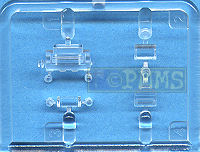
This is another nicely done kit with clean crisp details and is fairly easy to assembly but there are a few detail and minor fit issues to deal with along the way.
It will build into a good looking kit from the box and if you aren’t bothered with the issues outlined above then it will be even easier but to correct the issues, especially the driver's plate and fender kink will require a bit of work but less so for the barrel and exhaust.
It’s good that Dragon have chosen this less common version as the first 38(t) release to give us a different looking vehicle before the release of the “standard” tank and hopefully other versions on the 38(t) chassis will follow.
Recommended with reservations on the fit and detail issues.
Click on thumbnails for larger view





Detail images



Close new window to return to review
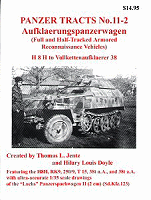 Aufkläerungspanzer Reconnaissance Vehicles Panzer Tracts No.11-2 ISBN 0-9744862-2-1 |
 PzKpfw 38 (t) Tank Power Vol.XXI Wydawnictwo Militaria No.241 ISBN: 83-7219-241-3 |
 TANKS & ARMOUR: PANZER 38(t) Ian Allen Publishing 96 pages, Soft Cover ISBN: 071103091X |
 PRAGA LT vz.38 P zKpfw 38(t) MBI Publishing ISBN: 80-86524-01-9 |
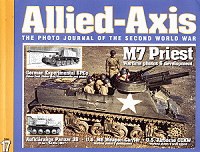 Allied-Axis The Photo Journal of the Second World War No.17 Ampersand Publishing. The publishers of MMIR magazine. |
 Panzer Tracts No.13 Panzerspaehwagen Armored Cars Sd.Kfz.3 to Sd.Kfz.263 ISBN 0-9708407-4-8 |
 Museum Ordnance Special #24 Schwerer Panzerspaehwagen Sd.Kfz.234 Darlington Productions Inc. |
 Pz.Kpfw 38(t)Ausf.A-D in detail Special Museum Line No.38 Wings & Wheels Publications ISBN 80-86416-58-5 |
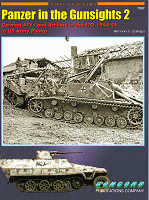 Panzer in the Gunsights 2 Steven J. Zaloga Concord Publications ISBN: 962-361-109-9 |
Thanks to my credit card and the excellent service from for
the review kit.
for
the review kit.



